标签:
模块,用一砣代码实现了某个功能的代码集合。
类似于函数式编程和面向过程编程,函数式编程则完成一个功能,其他代码用来调用即可,提供了代码的重用性和代码间的耦合。而对于一个复杂的功能来,可能需要多个函数才能完成(函数又可以在不同的.py文件中),n个 .py 文件组成的代码集合就称为模块。
如:os 是系统相关的模块;file是文件操作相关的模块
模块分为三种:
1、定义模块
情景一:

情景二:

情景三:
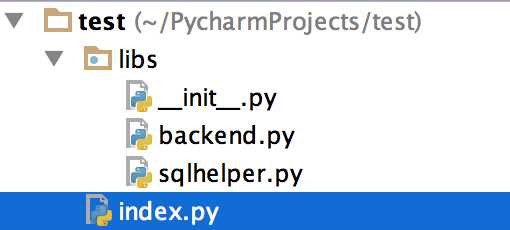
2、导入模块
Python之所以应用越来越广泛,在一定程度上也依赖于其为程序员提供了大量的模块以供使用,如果想要使用模块,则需要导入。导入模块有一下几种方法:
1 import module 2 from module.xx.xx import xx 3 from module.xx.xx import xx as rename 4 from module.xx.xx import *
导入模块其实就是告诉Python解释器去解释那个py文件
那么问题来了,导入模块时是根据那个路径作为基准来进行的呢?即:sys.path

import sys print sys.path 结果: [‘/Users/wupeiqi/PycharmProjects/calculator/p1/pp1‘, ‘/usr/local/lib/python2.7/site-packages/setuptools-15.2-py2.7.egg‘, ‘/usr/local/lib/python2.7/site-packages/distribute-0.6.28-py2.7.egg‘, ‘/usr/local/lib/python2.7/site-packages/MySQL_python-1.2.4b4-py2.7-macosx-10.10-x86_64.egg‘, ‘/usr/local/lib/python2.7/site-packages/xlutils-1.7.1-py2.7.egg‘, ‘/usr/local/lib/python2.7/site-packages/xlwt-1.0.0-py2.7.egg‘, ‘/usr/local/lib/python2.7/site-packages/xlrd-0.9.3-py2.7.egg‘, ‘/usr/local/lib/python2.7/site-packages/tornado-4.1-py2.7-macosx-10.10-x86_64.egg‘, ‘/usr/local/lib/python2.7/site-packages/backports.ssl_match_hostname-3.4.0.2-py2.7.egg‘, ‘/usr/local/lib/python2.7/site-packages/certifi-2015.4.28-py2.7.egg‘, ‘/usr/local/lib/python2.7/site-packages/pyOpenSSL-0.15.1-py2.7.egg‘, ‘/usr/local/lib/python2.7/site-packages/six-1.9.0-py2.7.egg‘, ‘/usr/local/lib/python2.7/site-packages/cryptography-0.9.1-py2.7-macosx-10.10-x86_64.egg‘, ‘/usr/local/lib/python2.7/site-packages/cffi-1.1.1-py2.7-macosx-10.10-x86_64.egg‘, ‘/usr/local/lib/python2.7/site-packages/ipaddress-1.0.7-py2.7.egg‘, ‘/usr/local/lib/python2.7/site-packages/enum34-1.0.4-py2.7.egg‘, ‘/usr/local/lib/python2.7/site-packages/pyasn1-0.1.7-py2.7.egg‘, ‘/usr/local/lib/python2.7/site-packages/idna-2.0-py2.7.egg‘, ‘/usr/local/lib/python2.7/site-packages/pycparser-2.13-py2.7.egg‘, ‘/usr/local/lib/python2.7/site-packages/Django-1.7.8-py2.7.egg‘, ‘/usr/local/lib/python2.7/site-packages/paramiko-1.10.1-py2.7.egg‘, ‘/usr/local/lib/python2.7/site-packages/gevent-1.0.2-py2.7-macosx-10.10-x86_64.egg‘, ‘/usr/local/lib/python2.7/site-packages/greenlet-0.4.7-py2.7-macosx-10.10-x86_64.egg‘, ‘/Users/wupeiqi/PycharmProjects/calculator‘, ‘/usr/local/Cellar/python/2.7.9/Frameworks/Python.framework/Versions/2.7/lib/python27.zip‘, ‘/usr/local/Cellar/python/2.7.9/Frameworks/Python.framework/Versions/2.7/lib/python2.7‘, ‘/usr/local/Cellar/python/2.7.9/Frameworks/Python.framework/Versions/2.7/lib/python2.7/plat-darwin‘, ‘/usr/local/Cellar/python/2.7.9/Frameworks/Python.framework/Versions/2.7/lib/python2.7/plat-mac‘, ‘/usr/local/Cellar/python/2.7.9/Frameworks/Python.framework/Versions/2.7/lib/python2.7/plat-mac/lib-scriptpackages‘, ‘/usr/local/Cellar/python/2.7.9/Frameworks/Python.framework/Versions/2.7/lib/python2.7/lib-tk‘, ‘/usr/local/Cellar/python/2.7.9/Frameworks/Python.framework/Versions/2.7/lib/python2.7/lib-old‘, ‘/usr/local/Cellar/python/2.7.9/Frameworks/Python.framework/Versions/2.7/lib/python2.7/lib-dynload‘, ‘/usr/local/lib/python2.7/site-packages‘, ‘/Library/Python/2.7/site-packages‘]
如果sys.path路径列表没有你想要的路径,可以通过 sys.path.append(‘路径‘) 添加。
通过os模块可以获取各种目录,例如:
 View Code
View Code 一、下载安装
下载安装有两种方式:
 方式一
方式一 方式二
方式二注:在使用源码安装时,需要使用到gcc编译和python开发环境,所以,需要先执行:
|
1
2
3
4
|
yum install gccyum install python-devel或apt-get python-dev |
安装成功后,模块会自动安装到 sys.path 中的某个目录中,如:
|
1
|
/usr/lib/python2.7/site-packages/ |
二、导入模块
同自定义模块中导入的方式
三、模块 paramiko
paramiko是一个用于做远程控制的模块,使用该模块可以对远程服务器进行命令或文件操作,值得一说的是,fabric和ansible内部的远程管理就是使用的paramiko来现实。
1、下载安装
|
1
2
3
4
5
6
7
8
9
10
11
12
13
14
15
16
17
18
19
|
# pycrypto,由于 paramiko 模块内部依赖pycrypto,所以先下载安装pycrypto# 下载安装 pycryptowget http://files.cnblogs.com/files/wupeiqi/pycrypto-2.6.1.tar.gztar -xvf pycrypto-2.6.1.tar.gzcd pycrypto-2.6.1python setup.py buildpython setup.py install# 进入python环境,导入Crypto检查是否安装成功# 下载安装 paramikowget http://files.cnblogs.com/files/wupeiqi/paramiko-1.10.1.tar.gztar -xvf paramiko-1.10.1.tar.gzcd paramiko-1.10.1python setup.py buildpython setup.py install# 进入python环境,导入paramiko检查是否安装成功 |
2、使用模块
 执行命令 - 通过用户名和密码连接服务器
执行命令 - 通过用户名和密码连接服务器 执行命令 - 过密钥链接服务器
执行命令 - 过密钥链接服务器 上传或者下载文件 - 通过用户名和密码
上传或者下载文件 - 通过用户名和密码 上传或下载文件 - 通过密钥
上传或下载文件 - 通过密钥一、os
用于提供系统级别的操作
os.getcwd() 获取当前工作目录,即当前python脚本工作的目录路径
os.chdir("dirname") 改变当前脚本工作目录;相当于shell下cd
os.curdir 返回当前目录: (‘.‘)
os.pardir 获取当前目录的父目录字符串名:(‘..‘)
os.makedirs(‘dirname1/dirname2‘) 可生成多层递归目录
os.removedirs(‘dirname1‘) 若目录为空,则删除,并递归到上一级目录,如若也为空,则删除,依此类推
os.mkdir(‘dirname‘) 生成单级目录;相当于shell中mkdir dirname
os.rmdir(‘dirname‘) 删除单级空目录,若目录不为空则无法删除,报错;相当于shell中rmdir dirname
os.listdir(‘dirname‘) 列出指定目录下的所有文件和子目录,包括隐藏文件,并以列表方式打印
os.remove() 删除一个文件
os.rename("oldname","newname") 重命名文件/目录
os.stat(‘path/filename‘) 获取文件/目录信息
os.sep 输出操作系统特定的路径分隔符,win下为"\\",Linux下为"/"
os.linesep 输出当前平台使用的行终止符,win下为"\t\n",Linux下为"\n"
os.pathsep 输出用于分割文件路径的字符串
os.name 输出字符串指示当前使用平台。win->‘nt‘; Linux->‘posix‘
os.system("bash command") 运行shell命令,直接显示
os.environ 获取系统环境变量
os.path.abspath(path) 返回path规范化的绝对路径
os.path.split(path) 将path分割成目录和文件名二元组返回
os.path.dirname(path) 返回path的目录。其实就是os.path.split(path)的第一个元素
os.path.basename(path) 返回path最后的文件名。如何path以/或\结尾,那么就会返回空值。即os.path.split(path)的第二个元素
os.path.exists(path) 如果path存在,返回True;如果path不存在,返回False
os.path.isabs(path) 如果path是绝对路径,返回True
os.path.isfile(path) 如果path是一个存在的文件,返回True。否则返回False
os.path.isdir(path) 如果path是一个存在的目录,则返回True。否则返回False
os.path.join(path1[, path2[, ...]]) 将多个路径组合后返回,第一个绝对路径之前的参数将被忽略
os.path.getatime(path) 返回path所指向的文件或者目录的最后存取时间
os.path.getmtime(path) 返回path所指向的文件或者目录的最后修改时间
更多猛击这里
二、sys
用于提供对解释器相关的操作
sys.argv 命令行参数List,第一个元素是程序本身路径 sys.exit(n) 退出程序,正常退出时exit(0) sys.version 获取Python解释程序的版本信息 sys.maxint 最大的Int值 sys.path 返回模块的搜索路径,初始化时使用PYTHONPATH环境变量的值 sys.platform 返回操作系统平台名称 sys.stdout.write(‘please:‘) val = sys.stdin.readline()[:-1]
更多猛击这里
三、hashlib
用于加密相关的操作,代替了md5模块和sha模块,主要提供 SHA1, SHA224, SHA256, SHA384, SHA512 ,MD5 算法
 md5-废弃
md5-废弃 sha-废弃
sha-废弃|
1
2
3
4
5
6
7
8
9
10
11
12
13
14
15
16
17
18
19
20
21
22
23
24
25
26
27
28
29
30
31
32
|
import hashlib# ######## md5 ########hash = hashlib.md5()hash.update(‘admin‘)print hash.hexdigest()# ######## sha1 ########hash = hashlib.sha1()hash.update(‘admin‘)print hash.hexdigest()# ######## sha256 ########hash = hashlib.sha256()hash.update(‘admin‘)print hash.hexdigest()# ######## sha384 ########hash = hashlib.sha384()hash.update(‘admin‘)print hash.hexdigest()# ######## sha512 ########hash = hashlib.sha512()hash.update(‘admin‘)print hash.hexdigest() |
以上加密算法虽然依然非常厉害,但时候存在缺陷,即:通过撞库可以反解。所以,有必要对加密算法中添加自定义key再来做加密。
|
1
2
3
4
5
6
7
|
import hashlib# ######## md5 ########hash = hashlib.md5(‘898oaFs09f‘)hash.update(‘admin‘)print hash.hexdigest() |
还不够吊?python 还有一个 hmac 模块,它内部对我们创建 key 和 内容 再进行处理然后再加密
|
1
2
3
4
|
import hmach = hmac.new(‘wueiqi‘)h.update(‘hellowo‘)print h.hexdigest() |
不能再牛逼了!!!
四、json 和 pickle
用于序列化的两个模块
Json模块提供了四个功能:dumps、dump、loads、load
pickle模块提供了四个功能:dumps、dump、loads、load
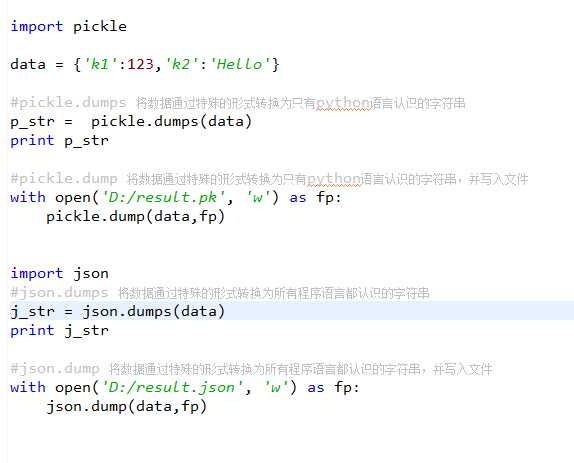
五、执行系统命令
可以执行shell命令的相关模块和函数有:
 commands
commands以上执行shell命令的相关的模块和函数的功能均在 subprocess 模块中实现,并提供了更丰富的功能。
call
执行命令,返回状态码
|
1
2
|
ret = subprocess.call(["ls", "-l"], shell=False)ret = subprocess.call("ls -l", shell=True) |
shell = True ,允许 shell 命令是字符串形式
check_call
执行命令,如果执行状态码是 0 ,则返回0,否则抛异常
|
1
2
|
subprocess.check_call(["ls", "-l"])subprocess.check_call("exit 1", shell=True) |
check_output
执行命令,如果状态码是 0 ,则返回执行结果,否则抛异常
|
1
2
|
subprocess.check_output(["echo", "Hello World!"])subprocess.check_output("exit 1", shell=True) |
subprocess.Popen(...)
用于执行复杂的系统命令
参数:
 执行普通命令
执行普通命令终端输入的命令分为两种:
 View Code
View Code View Code
View Code View Code
View Code View Code
View Code更多猛击这里
六、shutil
高级的 文件、文件夹、压缩包 处理模块
shutil.copyfileobj(fsrc, fdst[, length])
将文件内容拷贝到另一个文件中,可以部分内容
 View Code
View Codeshutil.copyfile(src, dst)
拷贝文件
 View Code
View Codeshutil.copymode(src, dst)
仅拷贝权限。内容、组、用户均不变
 View Code
View Codeshutil.copystat(src, dst)
拷贝状态的信息,包括:mode bits, atime, mtime, flags
 View Code
View Codeshutil.copy(src, dst)
拷贝文件和权限
 View Code
View Codeshutil.copy2(src, dst)
拷贝文件和状态信息
 View Code
View Codeshutil.ignore_patterns(*patterns)
shutil.copytree(src, dst, symlinks=False, ignore=None)
递归的去拷贝文件
例如:copytree(source, destination, ignore=ignore_patterns(‘*.pyc‘, ‘tmp*‘))
 View Code
View Codeshutil.rmtree(path[, ignore_errors[, onerror]])
递归的去删除文件
 View Code
View Codeshutil.move(src, dst)
递归的去移动文件
 View Code
View Codeshutil.make_archive(base_name, format,...)
创建压缩包并返回文件路径,例如:zip、tar
|
1
2
3
4
5
6
7
8
9
|
#将 /Users/wupeiqi/Downloads/test 下的文件打包放置当前程序目录import shutilret = shutil.make_archive("wwwwwwwwww", ‘gztar‘, root_dir=‘/Users/wupeiqi/Downloads/test‘)#将 /Users/wupeiqi/Downloads/test 下的文件打包放置 /Users/wupeiqi/目录import shutilret = shutil.make_archive("/Users/wupeiqi/wwwwwwwwww", ‘gztar‘, root_dir=‘/Users/wupeiqi/Downloads/test‘) |
 View Code
View Codeshutil 对压缩包的处理是调用 ZipFile 和 TarFile 两个模块来进行的,详细:
 zipfile 压缩解压
zipfile 压缩解压 tarfile 压缩解压
tarfile 压缩解压 ZipFile
ZipFile TarFile
TarFile 七、ConfigParser
用于对特定的配置进行操作,当前模块的名称在 python 3.x 版本中变更为 configparser。
|
1
2
3
4
5
6
7
8
9
|
# 注释1; 注释2[section1]k1 = v1k2:v2[section2]k1 = v1 |
|
1
2
3
4
5
6
7
8
9
10
11
12
13
14
15
16
17
18
19
20
21
22
23
24
25
26
27
28
29
30
31
|
import ConfigParserconfig = ConfigParser.ConfigParser()config.read(‘i.cfg‘)# ########## 读 ###########secs = config.sections()#print secs#options = config.options(‘group2‘)#print options#item_list = config.items(‘group2‘)#print item_list#val = config.get(‘group1‘,‘key‘)#val = config.getint(‘group1‘,‘key‘)# ########## 改写 ###########sec = config.remove_section(‘group1‘)#config.write(open(‘i.cfg‘, "w"))#sec = config.has_section(‘wupeiqi‘)#sec = config.add_section(‘wupeiqi‘)#config.write(open(‘i.cfg‘, "w"))#config.set(‘group2‘,‘k1‘,11111)#config.write(open(‘i.cfg‘, "w"))#config.remove_option(‘group2‘,‘age‘)#config.write(open(‘i.cfg‘, "w")) |
八、logging
用于便捷记录日志且线程安全的模块
|
1
2
3
4
5
6
7
8
9
10
11
12
13
14
|
import logginglogging.basicConfig(filename=‘log.log‘, format=‘%(asctime)s - %(name)s - %(levelname)s -%(module)s: %(message)s‘, datefmt=‘%Y-%m-%d %H:%M:%S %p‘, level=10)logging.debug(‘debug‘)logging.info(‘info‘)logging.warning(‘warning‘)logging.error(‘error‘)logging.critical(‘critical‘)logging.log(10,‘log‘) |
对于等级:
|
1
2
3
4
5
6
7
8
|
CRITICAL = 50FATAL = CRITICALERROR = 40WARNING = 30WARN = WARNINGINFO = 20DEBUG = 10NOTSET = 0 |
只有大于当前日志等级的操作才会被记录。
对于格式,有如下属性可是配置:
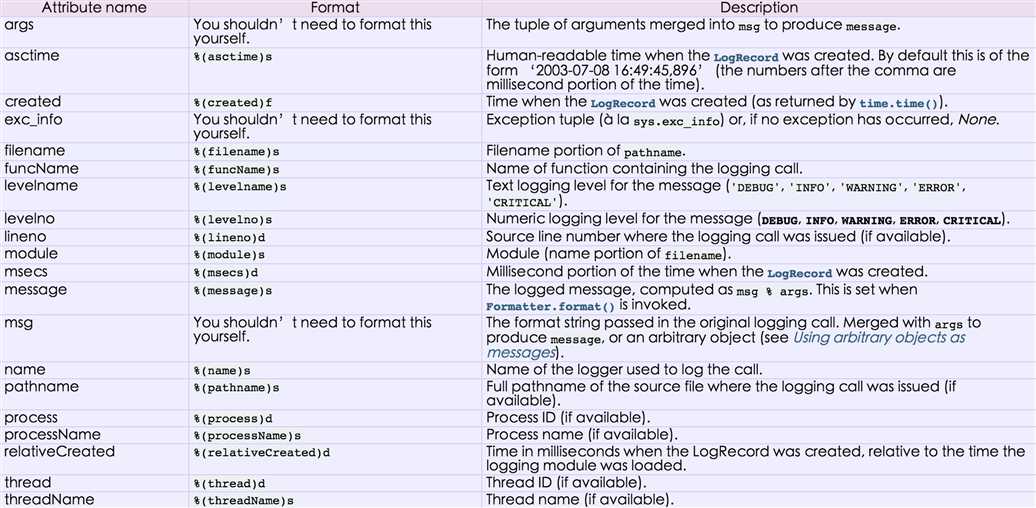
九、time
时间相关的操作,时间有三种表示方式:
|
1
2
3
4
5
6
7
8
9
10
11
12
13
14
15
16
17
18
19
20
21
22
23
24
25
|
print time.time()print time.mktime(time.localtime()) print time.gmtime() #可加时间戳参数print time.localtime() #可加时间戳参数print time.strptime(‘2014-11-11‘, ‘%Y-%m-%d‘) print time.strftime(‘%Y-%m-%d‘) #默认当前时间print time.strftime(‘%Y-%m-%d‘,time.localtime()) #默认当前时间print time.asctime()print time.asctime(time.localtime())print time.ctime(time.time()) import datetime‘‘‘datetime.date:表示日期的类。常用的属性有year, month, daydatetime.time:表示时间的类。常用的属性有hour, minute, second, microseconddatetime.datetime:表示日期时间datetime.timedelta:表示时间间隔,即两个时间点之间的长度timedelta([days[, seconds[, microseconds[, milliseconds[, minutes[, hours[, weeks]]]]]]])strftime("%Y-%m-%d")‘‘‘import datetimeprint datetime.datetime.now()print datetime.datetime.now() - datetime.timedelta(days=5) |
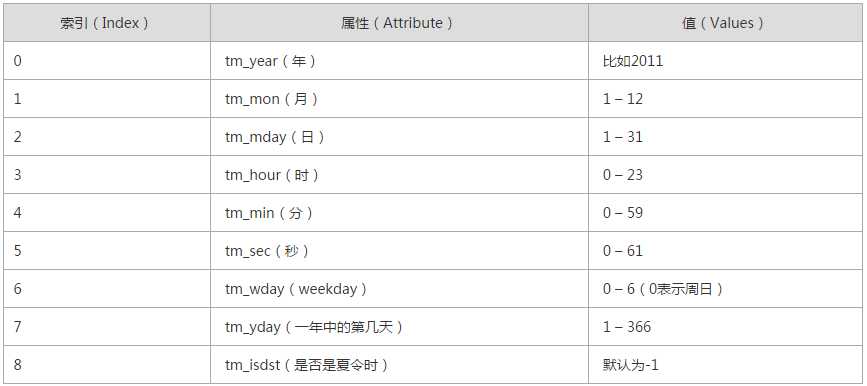
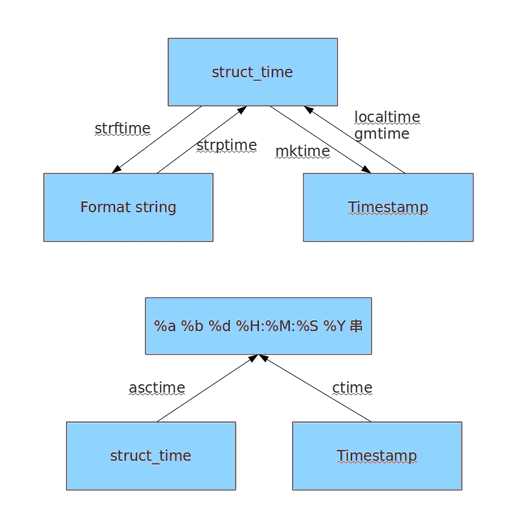
十、re
re模块用于对python的正则表达式的操作。
字符:
. 匹配除换行符以外的任意字符
\w 匹配字母或数字或下划线或汉字
\s 匹配任意的空白符
\d 匹配数字
\b 匹配单词的开始或结束
^ 匹配字符串的开始
$ 匹配字符串的结束
次数:
* 重复零次或更多次
+ 重复一次或更多次
? 重复零次或一次
{n} 重复n次
{n,} 重复n次或更多次
{n,m} 重复n到m次
IP:
^(25[0-5]|2[0-4]\d|[0-1]?\d?\d)(\.(25[0-5]|2[0-4]\d|[0-1]?\d?\d)){3}$
手机号:
^1[3|4|5|8][0-9]\d{8}$
1、match(pattern, string, flags=0)
从起始位置开始根据模型去字符串中匹配指定内容,匹配单个
import re
obj = re.match(‘\d+‘, ‘123uuasf‘)
if obj:
print obj.group()
 flags
flags2、search(pattern, string, flags=0)
根据模型去字符串中匹配指定内容,匹配单个
import re
obj = re.search(‘\d+‘, ‘u123uu888asf‘)
if obj:
print obj.group()
3、group和groups
a = "123abc456"
print re.search("([0-9]*)([a-z]*)([0-9]*)", a).group()
print re.search("([0-9]*)([a-z]*)([0-9]*)", a).group(0)
print re.search("([0-9]*)([a-z]*)([0-9]*)", a).group(1)
print re.search("([0-9]*)([a-z]*)([0-9]*)", a).group(2)
print re.search("([0-9]*)([a-z]*)([0-9]*)", a).groups()
4、findall(pattern, string, flags=0)
上述两中方式均用于匹配单值,即:只能匹配字符串中的一个,如果想要匹配到字符串中所有符合条件的元素,则需要使用 findall。
import re obj = re.findall(‘\d+‘, ‘fa123uu888asf‘) print obj
5、sub(pattern, repl, string, count=0, flags=0)
用于替换匹配的字符串
content = "123abc456" new_content = re.sub(‘\d+‘, ‘sb‘, content) # new_content = re.sub(‘\d+‘, ‘sb‘, content, 1) print new_content
相比于str.replace功能更加强大
6、split(pattern, string, maxsplit=0, flags=0)
根据指定匹配进行分组
content = "‘1 - 2 * ((60-30+1*(9-2*5/3+7/3*99/4*2998+10*568/14))-(-4*3)/(16-3*2) )‘" new_content = re.split(‘\*‘, content) # new_content = re.split(‘\*‘, content, 1) print new_content
content = "‘1 - 2 * ((60-30+1*(9-2*5/3+7/3*99/4*2998+10*568/14))-(-4*3)/(16-3*2) )‘" new_content = re.split(‘[\+\-\*\/]+‘, content) # new_content = re.split(‘\*‘, content, 1) print new_content
inpp = ‘1-2*((60-30 +(-40-5)*(9-2*5/3 + 7 /3*99/4*2998 +10 * 568/14 )) - (-4*3)/ (16-3*2))‘
inpp = re.sub(‘\s*‘,‘‘,inpp)
new_content = re.split(‘\(([\+\-\*\/]?\d+[\+\-\*\/]?\d+){1}\)‘, inpp, 1)
print new_content
相比于str.split更加强大
实例:计算器源码
十一、random
随机数
|
1
2
3
4
|
mport randomprint random.random()print random.randint(1,2)print random.randrange(1,10) |
随机验证码实例:
|
1
2
3
4
5
6
7
8
9
10
|
import randomcheckcode = ‘‘for i in range(4): current = random.randrange(0,4) if current != i: temp = chr(random.randint(65,90)) else: temp = random.randint(0,9) checkcode += str(temp)print checkcode |
标签:
原文地址:http://www.cnblogs.com/zhming26/p/5453907.html